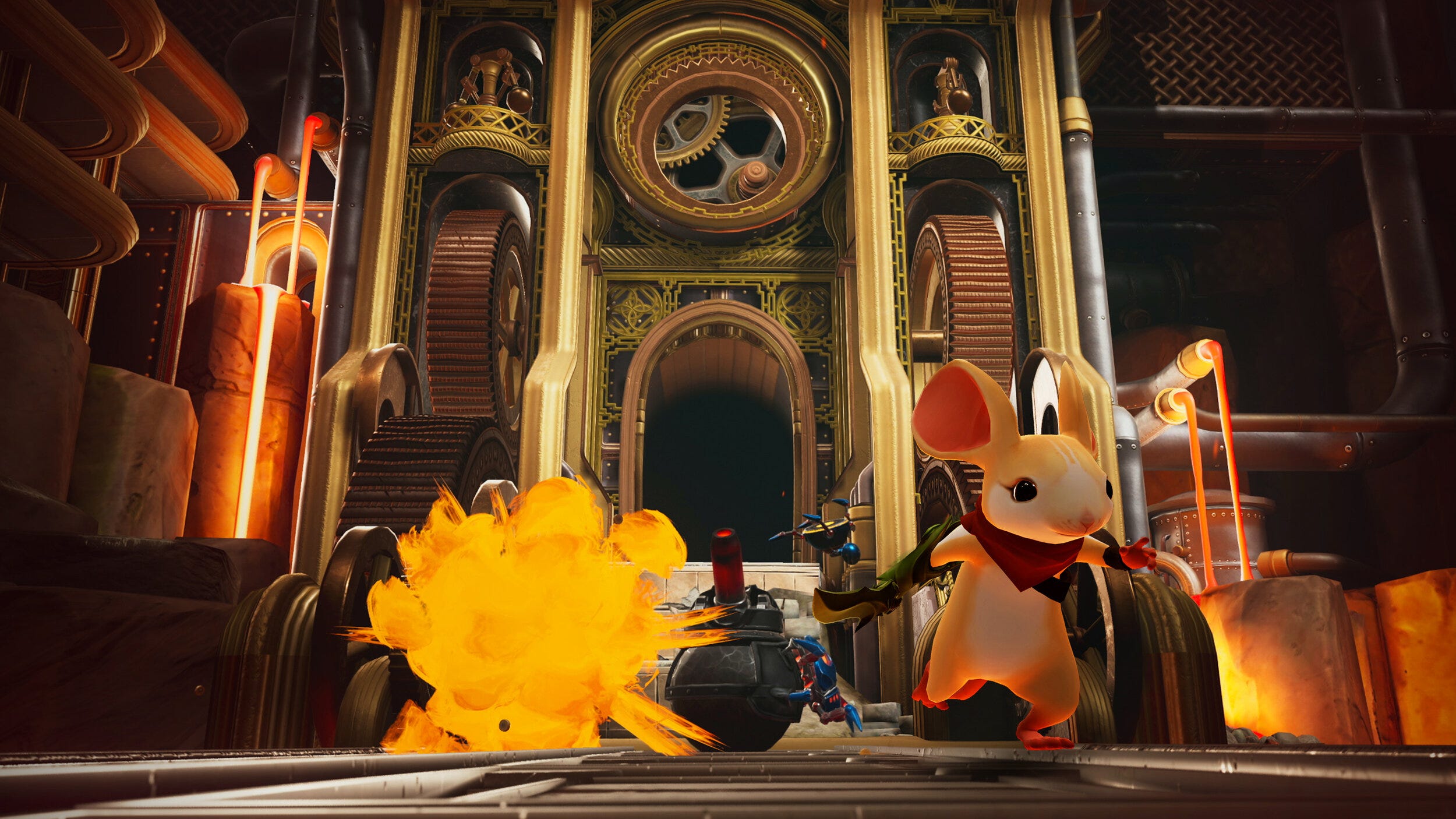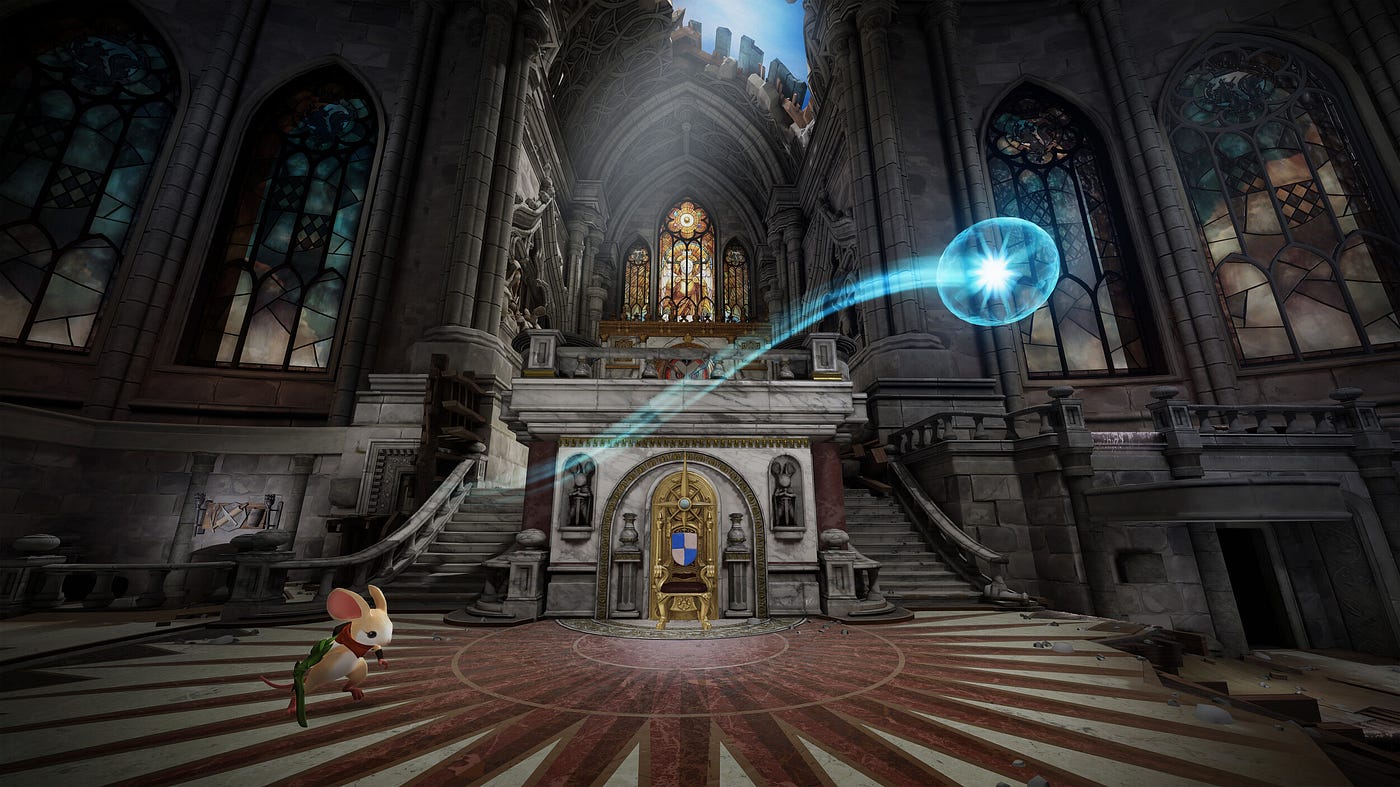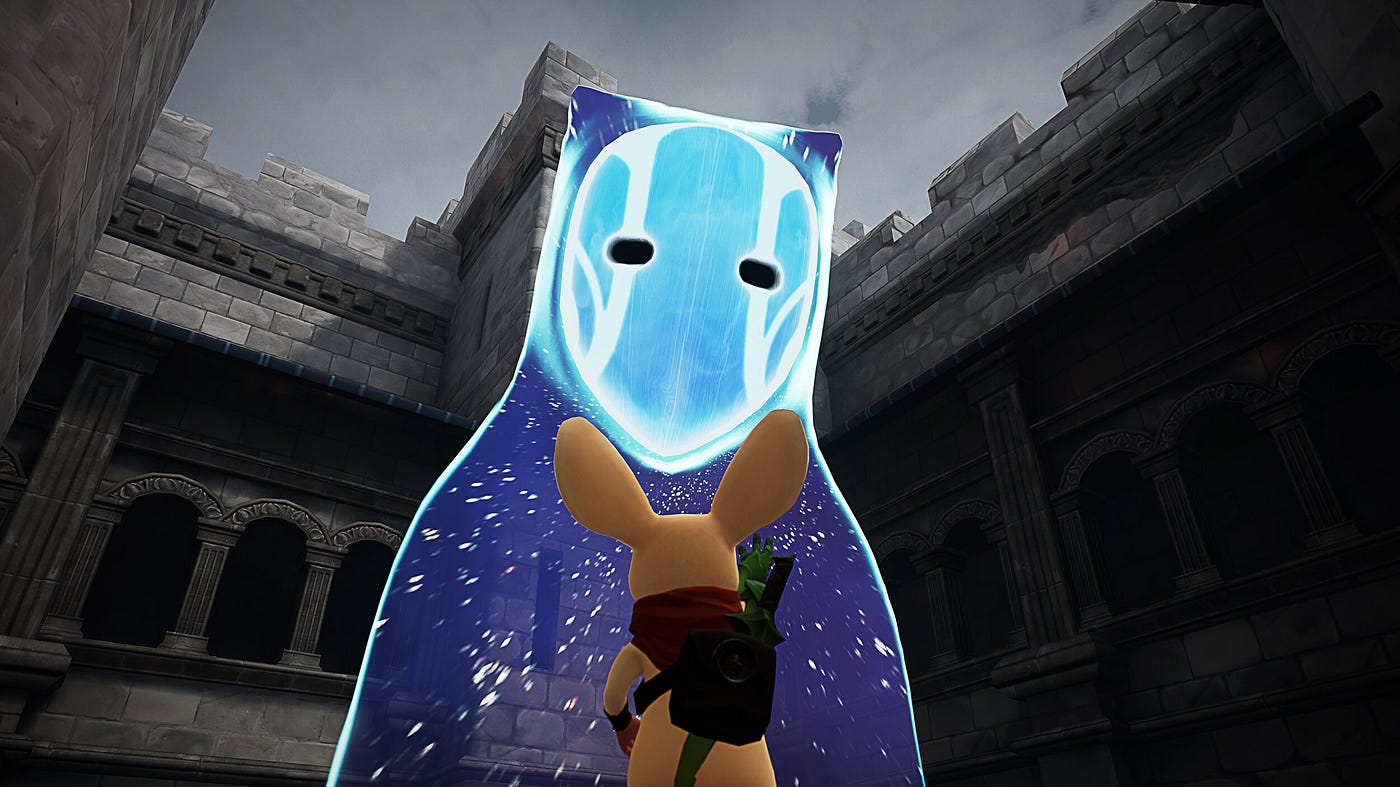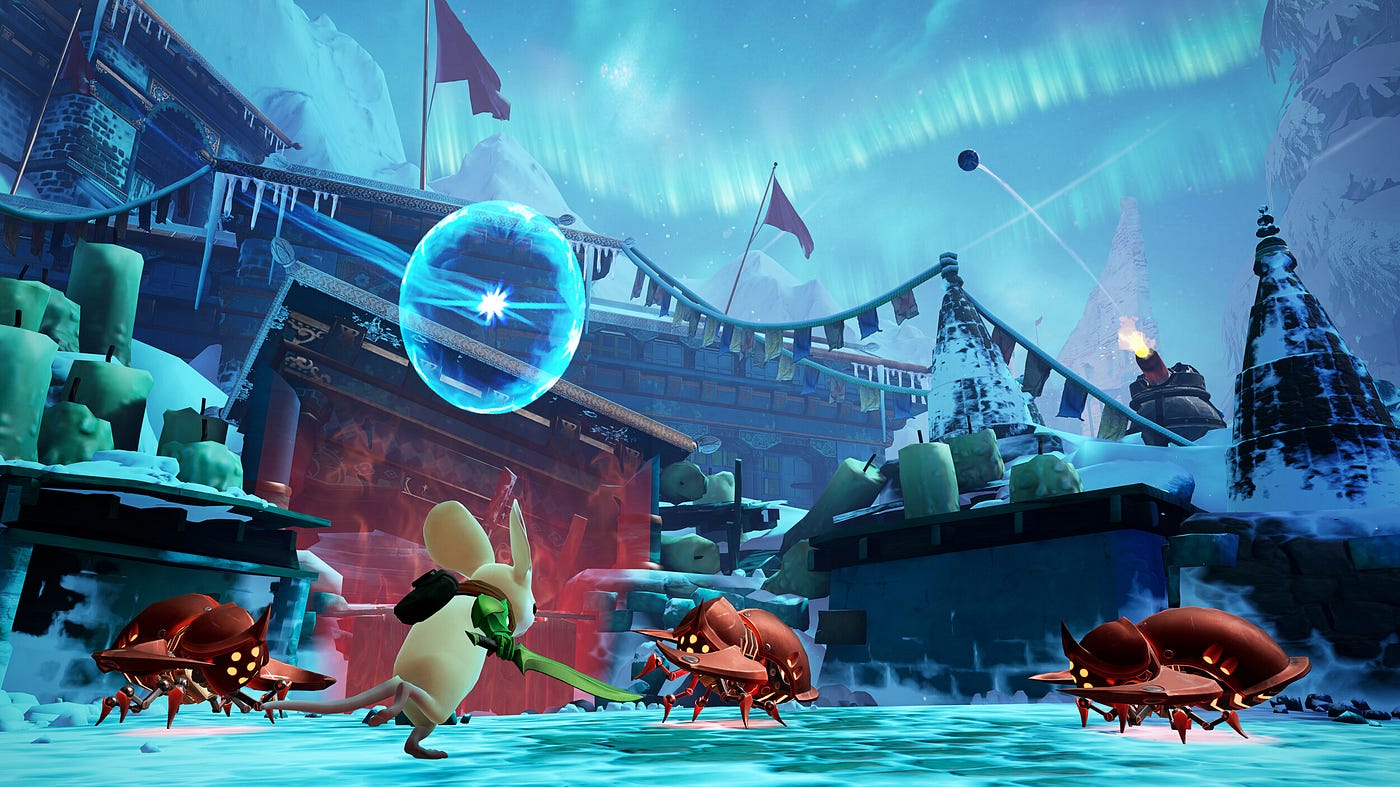‘Moss: Book II’ Is An Atmospheric Wonderland Adventure (VR Review)
Polyarc takes this sequel to new heights by focusing on character and environment


It’s a quiet, sunny day in a cavernous library hall. There are several stacks of aged, well-worn books within arms reach on the table before me. One seemingly lights up, catching my eye. Being alone with nothing else to do, I grab the book, examining it. “Moss” is embossed in gold letters on the cover, along with the silhouette of a tiny mouse armed with a sword.
As I crack the book open, music swells round me. There is no text; only colorful illustrations radiantly shimmering with an airy female voice providing narration. I rapidly turn the pages, becoming engrossed by the book’s contents. When I reach a glowing white page, it becomes brighter, until the book, table, and the library hall disappear.
Rather than the story of “Moss” leaping off the page, I find myself having leapt into the book. And looking up at me, enthusiastically waving a warm greeting, is a mouse. Her name is Quill, an old friend I haven’t seen in a long time. I find myself waving back instinctively, ready to begin our grand adventure’s next chapter.
Moss: Book II is a narrative VR platform puzzler game from Polyarc. It’s a sequel to the original game, simply entitled Moss, that’s available on Oculus Quest and PS VR (no PC/Steam launch date as of this review’s publication). The player dons the role of “The Reader,” an ethereal entity bound to Quill through one of five magic artifacts, each separately and collectively referred to as “Glass.” Quill lives in Moss, a fairytale land filled with creatures like her warrior mice tribe, manic wood fairies, and more. All of the creatures are more or less at war with the Arcane, mechanical monstrosities looking to combine the Glass in order to subjugate Moss.

As an immersive experience, Moss: Book II shines bright thanks to its captivating lead, Quill and how the player both witnesses and interacts with the many and varied realms of Moss. Part of this success is due to the original game. Like its predecessor, Moss: Book II has the player moving Quill through diorama-like landscapes, witnessing everything from a fixed and forced visual perspective. When Quill runs over a hill or through a door, there is the sound of a page turning, with another, different landscape appearing before the player.
In the original game, opportunities to interact with Quill were limited. She would provide hints through arm gestures and occasionally offer a paw for a high five. While those interactions return in Moss: Book II, there’s greater variety and depth. This is partially due to an expansion in the cast of characters (explaining further would broach several spoilers). Prompts to interact with other characters begin quite similarly, but quickly prove to be vastly different. This variety makes Quill and other characters feel alive, as if the player is interacting with live performers.
Throughout Moss: Book II, many of the landscapes require solving a puzzle. This, too, is a carry over from the original game. The player moves a piece of the landscape or an enemy, creating a path for Quill to move forward. But in the sequel, many puzzles require the player to manipulate the landscape several times in several different ways like creating a vine or breaking a stalactite.
Occasionally during these puzzles and one boss fight, Quill and the player actively work together to complete a task. By constantly interacting with the landscapes along with Quill, my agency has potency and meaning. I’m less of a passive observer in Quill’s journey this time, actively leaning forward when playing, becoming another creature circumnavigating Moss.

The cumulative effect of these elements produces something rather amazing — a personal connection with Quill. It isn’t her struggle to save Moss. It’s ours, as comrades in arms. Then, when Moss: Book II takes a dramatically tragic turn for Quill a third of the way in, I am so deeply concerned for her that tears well in my eyes. I desperately try to intervene to reverse what happened, attempting to interact even when I so clearly cannot, unable to help.
Get Patrick B. McLean’s stories in your inbox
Join Medium for free to get updates from this writer.
SubscribeSubscribe
I can’t think of a single video game experience, VR or otherwise, where I was so connected with a fictional character with no actual agency. This is a true testament to Polyarc’s ability to bring Quill to life, feeling so vividly real, so incredibly human.
Underneath my relationship with Quill, Polyarc’s work in breathing life into Moss itself elevates the entire experience. There are six realms featured, each dynamically different from the other. The first third mirrors the majority of the original game, featuring only stone castles and wooded forests. Quickly, and thankfully, those realms are replaced with snowy mountains and smoldering caves. As each realm is visually distinct, creating variety, the points of interaction for puzzle solving are different as well. This in turn feeds into the level of interaction I discussed earlier, allowing the player to actively look for new ways to engage every landscape.
Related, Moss: Book II returns the player to the library hall several times. It’s there where the story largely unfolds examining pages of still images while listening to the narration performed by Morla Gorrondona. There’s dynamic lighting used to draw the player’s attention to the page. But it’s how the library hall changes throughout that’s stunningly mesmerizing. When visiting Moss’ snow-covered realm, the library hall’s roof is gone, showcasing a shimmering night sky. Snow is falling, adding to the plentiful snow banks through the library hall. With the boundaries between the player’s world and that of Moss blurred, it heightens the immersion quite successfully.
Speaking of the narration, massive kudos to Gorrondona, who I believe does not receive enough credit for her voice work in either Moss game. On top of providing constant plot narration throughout the game, Gorrondona voices characters differently when performing dialogue. Her performance fosters a soothing, bedtime story quality and tone, adding a lovely layer of warmth and charm to the experience.

Now, as a video game, Moss: Book II is somewhat lacking. Combat is exactly the same from the original game for the first third of the sequel. Enemies are dispatched with Quill hitting them with her sword one to three times, depending on the enemy type. While the addition of new weapons later on is greatly welcomed, the only difference to defeating enemies is how many times you have to hit them. This generally makes combat feel like nothing more than filler half the time.
Additionally, the player becomes required to change Quill’s weapon to defeat certain enemies. To do so, the player has to hold down a button to open Quill’s inventory, go to the weapons section, grab the required weapon, and then hand it to Quill. I’ve encountered far worse item management in other VR games but it’s still not terribly intuitive and it was only in the last hour of gameplay when I finally got a handle on the weapon management.
Yet the combat gameplay shouldn’t stop immersive theatre fans and creators with a VR headset from playing Moss: Book II. It’s an excellent example of how placing focus on character and environment elevates the experience. It’s the kind of emphasis that should be present in all forms of immersive theatre, from remote to in-person work and everything in between.
In the growing pantheon of immersive VR experiences, Moss: Book II cements the franchise as a vital cornerstone in the foundation. The world building is top notch, the player agency plentiful, and the characters, primarily the mighty and loveable Quill, are so incredibly lifelike, you’ll forget they’re preprogrammed video game characters.
Moss: Book II is available now on Oculus Quest and PS VR. It is $39.99.
Discover the latest immersive events, festivals, workshops, and more at our new site EVERYTHING IMMERSIVE, new home of NoPro’s show listings.
NoPro is a labor of love made possible by our generous Patreon backers. Join them today!
In addition to the No Proscenium website, our podcast, and our newsletters, you can find NoPro on Twitter, Facebook, YouTube, Instagram, in the Facebook community Everything Immersive, and on our Discord.